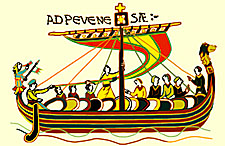| Athena Review Vol.1, no.3
| | |
The Vikings in Vinland (ca. AD 998-1002)
| | | | |
|
Two
types of evidence exist for Norse contacts with North America: written
sagas and archaeological findings. Vinland, southernmost of three
North American coastal areas described in Icelandic Sagas by Norse
explorers, was said to be rich in grapes, timber, and a self-sown
"wheat." Archaeological investigations in the 1960's at L'Anse aux
Meadows in Newfoundland discovered proof of an early 11th century AD
Norse settlement, defining both a Viking outpost in Canada, and contact
with North American natives called "Skraelings."
The Sagas: Two medieval Icelandic chronicles, the Graenlendinga Saga ("The Greenlander's Saga") and Eirik's Saga
comprise the primary written evidence for th e Norse landfall, relating
their sightings, explorations, and attempts at settlement in North
America. The landing on the northern coast of North America in ca. AD
998-1002 was only the last phase of a westward expansion from Norway
and Denmark across the north Atlantic, including the Orkney, Shetland,
and Faroe Islands (AD 780-800), Iceland (870) and Greenland (985/6). e Norse landfall, relating
their sightings, explorations, and attempts at settlement in North
America. The landing on the northern coast of North America in ca. AD
998-1002 was only the last phase of a westward expansion from Norway
and Denmark across the north Atlantic, including the Orkney, Shetland,
and Faroe Islands (AD 780-800), Iceland (870) and Greenland (985/6).
Fig.1: A Norse-like seagoing warship from the 11th century Bayeux tapestry.
As described in the Graenlendinga Saga,
Bjarni Herjolfsson was the first to sight the North American coast
around 985 AD, but did not allow his crew to land. Better known is the
Viking explorer Leif Eirikson (called Leif the Lucky), whose voyages to
the North American coasts are recorded in both of the Vinland sagas.
Thorfinn Karlsefni, an Icelandic trader, made a more permanent attempt
to settle in Vinland. Due to the uncertainty caused by constant Indian
attacks, however, this settlement was soon abandoned, the Vikings
returning to Greenland. They must have spent at least three years in
North America, as the saga relates that a son, Snorri, was born to
Karlsefni and that he was three when the colonizers abandoned the
Vinland site. Other documentary evidence for the Vinland
settlement comes from Adam of Bremen, a German cleric writing some time
shortly before 1076; and from the Icelandic Annals for AD 1121 and 1347.

Archaeological finds at L'Anse aux Meadows:
Routes of the Vikings' North American voyages and the location of the
various places mentioned in the sagas have been the subject of much
speculation. As the name Vinland probably reflects the presence of
grapes,some researchers believe that the Vikings sailed as far south as
Cape Cod, but that Vinland itself was just below the Gulf of St.
Lawrence.
Fig.2: Location of Epave Bay and L'Anse aux Meadows (inset).
In
1960, Norwegian archaeologists Helge Ingstad and his wife Anne Stine
discovered a short-lived Viking settlement at Epaves Bay in
Newfoundland. This site, called L'Anse aux Meadows (Meadow Cove), is
thus far the only Viking settlement to be discovered in North America.
Excavation has revealed the outlines of eight sod-walled structures,
one with features suggesting it was a bath-house of a type known from
the Norse occupation of Greenland. Iron nail fragments were found in
the house and pieces of iron together with slag were found in a
smithy. Other definite Norse artifacts include a soapstone
spindle whorl similar to those in use in Greenland and Iceland during
the 11th century, and a bronze-ringed pin. Radiocarbon testing from a
number of areas at the site produced a range of dates, many clustering
around A.D. 1000.
11th century AD Cultural Contacts:
Both peaceful and violent meetings between the Norsemen and natives are
recorded in the sagas. Skraelings, the Norse term for the natives,
included both northeastern Algonquin tribes (possibly Micmacs or
Beothuks) and Eskimos. The short accounts in the sagas provide
ta ntalizing glimpses of North American aboriginal physical appearances
and customs, as well as initial inter-cultural reaction. The Graenlendinga Saga
contains the first known record of an encounter between native North
Americans and Europeans, shortly after AD 1000. That narrative tells
how eight Indians were killed by Thorvald, Leif Eirikson's brother, and
the battle which ensued. ntalizing glimpses of North American aboriginal physical appearances
and customs, as well as initial inter-cultural reaction. The Graenlendinga Saga
contains the first known record of an encounter between native North
Americans and Europeans, shortly after AD 1000. That narrative tells
how eight Indians were killed by Thorvald, Leif Eirikson's brother, and
the battle which ensued.
Fig.3:
Plan of the early 11th century Viking site at L'Anse aux Meadows. 1:
Large house; 2-7: other structures 8: smithy, 9: possible charcoal
kiln; 10-11: large cooking pits. (after Ingstad 1974).
. |
|
| Main
index of Athena Review
Copyright © 2023 Rust Family Foundation
(All Rights Reserved). | | |
.
|